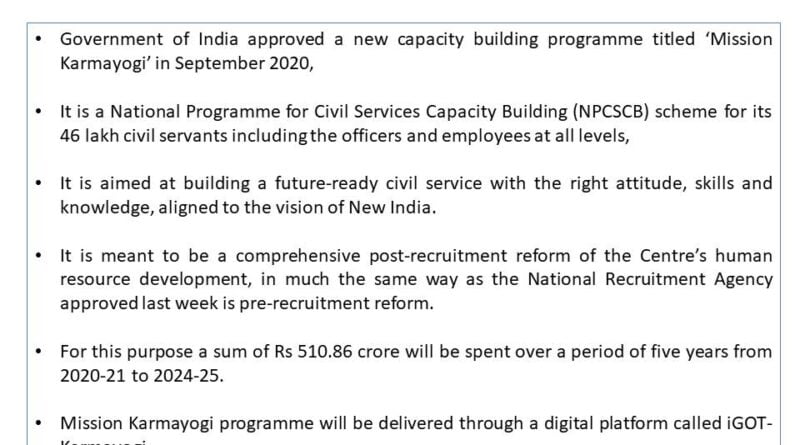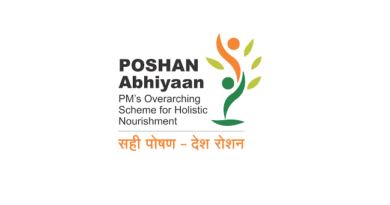Mission Karmayogi
Context:
Mission Karmayogi will be a key enabler in achieving the goal of $5 Trillion economy set by the Prime Minister says DrJitendra Singh
About Mission Karmayogi:
- The Government of India approved a new capacity building programme titled ‘Mission Karmayogi’ in September 2020,
- It is a National Programme for Civil Services Capacity Building (NPCSCB) scheme for its 46 lakh civil servants including the officers and employees at all levels,
- It is aimed at building a future-ready civil service with the right attitude, skills and knowledge, aligned to the vision of New India.
- It is meant to be a comprehensive post-recruitment reform of the Centre’s human resource development, in much the same way as the National Recruitment Agency approved last week is pre-recruitment reform.
- For this purpose a sum of Rs 510.86 crore will be spent over a period of five years from 2020-21 to 2024-25.
- Mission Karmayogi programme will be delivered through a digital platform called iGOT-Karmayogi.
- The iGOT initiative is aimed toward need-based capacity building of state and Central Government officers and to facilitate the outreach of training facilities for them.
- The aim is to harmonise the training standards, create shared faculty and resources, and have supervisory role over all Central Training Institutions.
- The ultimate goal of this scheme is to improve the capabilities of civil servants for ensuring efficient service delivery of the highest quality standards.
Six Pillar of Mission Karmayogi
Mission Karmayogi has the following six pillars:
- Policy Framework
- Institutional Framework
- Competency Framework
- Digital Learning Framework
- Electronic Human Resource Management System (e-HRMS)
- Monitoring and Evaluation Framework
Idea behind Mission Karmayogi
Civil services form the backbone of the Indian administration. Any reform taken to enhance the capacity building of the civil services is an important step towards better governance.
Steps to be taken to build the capacity of civil services:
- Linking the transformation of work culture
- Strengthening public institutions
- Adoption of modern technology
Apex Body of the Mission Karmayogi
The Public Human Resource Council under the chairmanship of the Prime Minister of India will be the apex body of the Mission Karmayogi. The other members of this council will include:
- Union Ministers
- Chief Ministers
- Eminent public HR practitioners
- Thinkers
- Global thought leaders and
- Public Service functionaries
Salient Features of Mission Karmayogi
Mission Karmayogi is a step towards improved human resource management practices in the government. It has the following features:
- The transition from Rules Based to Roles Based Human Resource (HR) Management – The focus is to allocate jobs to the civil servants based on their competencies.
- On-Site Learning to complement Off-Site Learning – It is a training given to the civil servants on-site.
- An ecosystem of shared training infrastructure – Civil servants to adapt to an ecosystem of shared learning materials, institutions and personnel.
- Framework of Roles, Activities and Competencies (FRACs) approach – All civil services positions to be calibrated under this approach. Also based on this approach, all learning content will be created and delivered to every single government entity.
- Behavioural, Functional and Domain Competencies – Civil Servants to build their competencies in their self-driven and mandated learning paths.
- Co-creation of the common ecosystem by all the Central Ministries, Departments and their organizations – This is a way to create an ecosystem of learning through an annual financial subscription for every employee.
- Partnership with learning content creators – Public training institutions, universities, start-tips and individual experts will be enabled to be a part of this capacity-building measure.
Need of The Mission
- There is a need to develop domain knowledge besides administrative capacity in the bureaucracy.
- There is a need to formalize the recruitment process and match the public service to a bureaucrat’s competence, so as to find the right person for the right job.
- The plan is to begin right at the recruitment level and then invest in building more capacity through the rest of their career.
- As the Indian economy grows, it will get more complex to govern; the governance capacities will have to be enhanced proportionately which this reform undertakes.
- The reforms in the Indian bureaucracy is the need of the hour and It is a major reform undertaken in recent years to transform it.
Other Reforms
- The Government has ended the hegemony of the Indian Administrative Service (IAS), the apex bureaucratic cadre, with respect to appointments at the level of joint secretary (JS).
- Instead, appointments to posts have been drawn from other cadres also like the Indian Revenue Service, Indian Accounts and Audit Service and the Indian Economic Service.
- It is estimated that now one in two JS level officers are drawn from cadres other than the IAS.
- Similarly, the Union government has also encouraged lateral induction of personnel from the private sector.
How will it work?
- The capacity building programme will be delivered through an Integrated Government Online Training or iGOT-Karmayogi digital platform, with content drawn from global best practices rooted in Indian national ethos.
- The platform will act as a launchpad for the National Programme for Civil Services Capacity Building (NPCSCB), which will enable a comprehensive reform of the capacity building apparatus at the individual, institutional and process levels.
- Officers will be evaluated on the basis of the courses they take throughout their career to enhance their skill.
- An online database will be maintained on what courses they have completed, how did they fare, what areas does their expertise lie in, etc.
- In case of any future vacancy or if an appointing authority is considering an officer, they can simply see what kind of training the officer has been getting.
Challenges
- John Maynard Keynes, the economist, once said that “The difficulty lies, not in the new ideas, but in escaping from the old ones.”
- There is a tendency in the Bureaucracy to resist the change which challenges their status quo.
- The bureaucracy too must understand the need of domain knowledge and the importance of moving away from generalist to specialist approach.
- In today’s world the governance is getting technical with each passing day and hence it’s important that the person in authority too should have the requisite skill and experience in that particular area.
- Thus, there should be a behavioural change in the bureaucracy too and they must embrace the change as a need of the hour and not an attack on their status quo.
- Moreover, these online courses must not become another opportunity for the officers to go for the sabbatical leaves.
- It must be ensured that they are actually attending the courses and participating in it so that the purpose doesn’t get defeated.
Institutional Framework of Mission Karmayogi
These following institutions will help in implementing the Mission Karmayogi:
- Prime Minister’s Public Human Resources (HR) Council
- Capacity Building Commission
- Special Purpose Vehicle for owning and operating the digital assets and the technological platform for online training
- Coordination Unit headed by the Cabinet Secretary
What are the objectives of the Capacity Building Commission under Mission Karmayogi?
- It will assist the Public Human Resource Council
- It will supervise all central training institutions which are enabled for civil services capacity building
- It will create external faculty and resource centres.
- It will assist stakeholder departments in the implementation of the capacity building programmes.
- It will put forth recommendations on the standardization of the training and capacity building, pedagogy and methodology
- It will suggest policy interventions related to the HR practises in the government.
Conclusion
- While this is a welcome move, it is also a fact that bureaucratic sloth is only one side of the coin.
- Equally culpable is the political interference which manifests itself in transfers which must be addressed too.
- Ashok Khemka, the IAS officer from Haryana, is a living testimony of it who has been transferred 52 times so far in his career.
- Clearly, the reform process is not going to be easy but this is a good move in the direction.
iGOT- Karmayogi platform
- iGOT stands for Integrated Govt. Online training’ (iGOT).
- It is a portal on the Ministry of HRD’s DIKSHA platform for the purpose of capacity building.
- iGOT-Karmayogi is a continuous online training platform, which would allow all government servants from assistant secretary to secretary level to undergo continuous training, depending on their domain areas.
- All kinds of Courses from international universities will be made available on the platform for officers to take.
- The platform is expected to evolve into a vibrant and world-class market place for content, where carefully curated and vetted digital e-learning material will be made available.
- Besides capacity building, service matters like confirmation after probation period, deployment, work assignment and notification of vacancies etc. would eventually be integrated with the proposed competency framework.
Source: PIB
You can find many articles on GOVERNANCE and CONSTITUTION (part of GS II) in our website. Go through these articles share with your friends and post your views in comment section.



